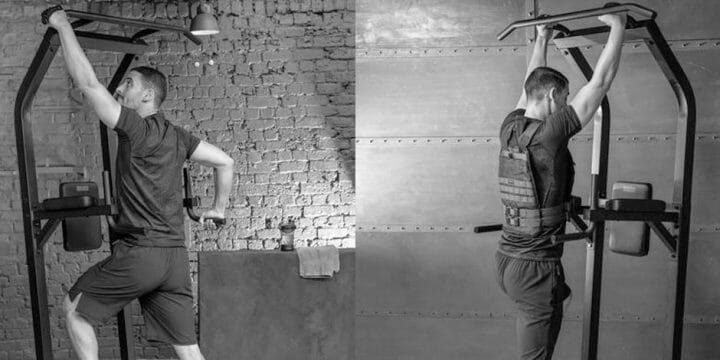- The best upper abs workouts include dumbbell crunches, tuck and crunch, modified v-ups, decline crunches, hanging sit-ups, and medicine ball sit-ups.
- The upper abs are also called rectus abdominis and form the top four bulges of the six-pack.
- According to a study from The Journal of Physiology, working your abs with time under tension can optimize muscle growth.
- We recommend training upper abs frequently, mixing different types of exercises, and steadily increasing the number of reps and sets as you get better.
7 Best Upper Ab Exercises
Years of ab training have taught me the importance of working the upper abs.
In my experience as a trainer, I've found seven ab exercises that helped me develop strong and defined upper abs.
Here are each of them, along with my set and rep recommendation.
1. Dumbbell Crunch (3 sets of 12–15 reps)
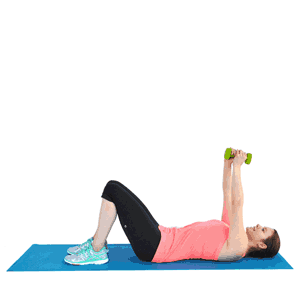
My favorite thing about the dumbbell crunch is that it's super beginner-friendly. I suggest picking a lightweight to start with
Here's how you do this exercise:
- Set yourself up on an exercise mat and lie down flat on your back.
- Hold a small dumbbell with your arms crossed over your rib cage.
- Place your feet flat on the floor with your knees at a right angle.
- Slowly start the weighted crunch by keeping your spine in a neutral curve.
- Once you get to the seated position, slowly lower your body back down again.
- Add more strain by keeping your legs straight.
2. Tuck And Crunch (3 sets of 20–25 reps)
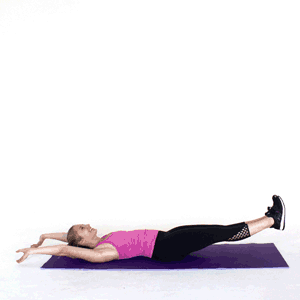
If you've already built up some strength in your abdominal muscles, I recommend this exercise as the next step up from the regular crunches.
Here's how you do this exercise:
- Lie flat on the exercise mat and place your hands behind your head.
- Lift your legs in the air with your knees at a right angle so that your calves are horizontal to the ground.
- Pull your upper body up towards the knees so that your shoulder blades and lower back lift off the ground.
- Touch the sides of your knees with your elbows and slowly lower down again.
3. Modified V-Ups (3 sets of 20–25 reps)
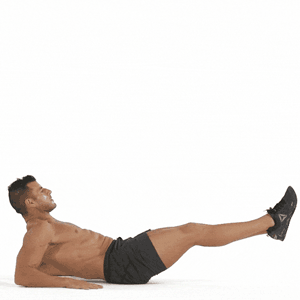
This is an excellent move that combines leg raises with sit-ups.
Here's how you do this exercise:
- Lie down flat on a yoga mat with your legs extended in a straight line.
- With your arms extended above your head, slowly lift your feet up as high as you can with your legs remaining straight.
- Lift your body off the ground and reach for your toes.
- Try to hold the top position for a second before lowering back down again.
4. Decline Crunches (3 sets of 20–25 reps)
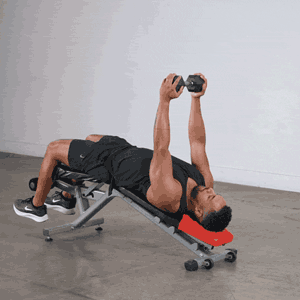
These are a nice step up from regular crunches, but you'll need a decline bench.
Here's how you do this exercise:
- Set up the bench at about a 30-degree angle and secure your feet.
- Keep your knees bent at about a 90-degree angle and lie down until your back is fully supported by the bench.
- Lift your upper torso towards your knees with your hands behind your head.
- Once your elbows touch your knees, slowly reverse your body back down again.
5. Hanging Sit-Ups (3 sets of 10–15 reps)
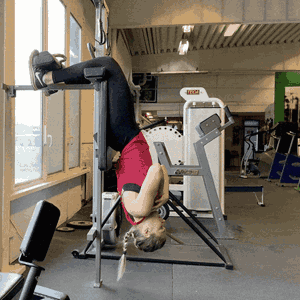
This is one of the tougher sit-ups you can do, and I suggest leaving these for a time when you've built up enough core strength.
They are essentially the opposite of the hanging leg raise.
Here's how you do this exercise:
- Ideally, use a secure inversion table or a pull-up frame with ankle straps to secure you upside down.
- Let your body hang down with your arms straight.
- Slowly pull your body upwards as far as you can and try to reach for your knees and toes.
- Go as far as possible and then lower yourself down again, and keep track of how far up you can get to measure your progress.
6. Medicine Ball Sit-Ups (3 sets of 15–20 reps)
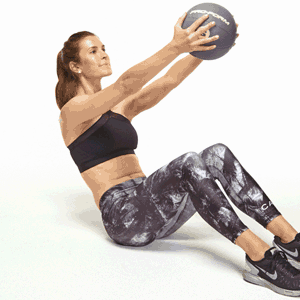
This is a good exercise that you can extend to your entire core muscles with a slight modification.
Here's how you do this exercise:
- Lay down on a yoga mat with your feet flat on the ground.
- Hold a medicine ball with your hands above your head, resting it on the ground.
- Keep your arms above your head and lift your body up into a sitting position.
- To target all of your core, throw the medicine ball against a wall in front of you with both hands and then catch the rebound.
- Now, slowly lower yourself back down again until the medicine ball touches the ground above your head.
Related: Best Weighted Ab Workouts
7. Hollow Hold (3 sets to failure)
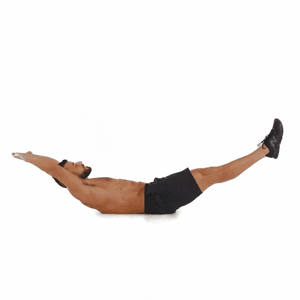
Our final exercise is an isometric hollow hold that you need to time.
Here's how you do this exercise:
- The starting position is on a yoga mat with your back on the ground and your knees tucked up to your chest.
- From here, slowly stretch out your legs, keeping your feet about a foot off the ground.
- Stretch out your arms above and behind your head at the same time and hold this static ab position for as long as possible.
What Are the Upper Abs?
The upper abs are called the rectus abdominis, and they form the four bulges at the top of the six-pack. When they are well-formed, they tend to be the more dominant abs, and they play a critical role in flexing your spine.
If you hold your hand on your core below your pecs and then bend and straighten your spine, you'll feel the rectus abdominis muscles with each movement.
Unlike the lower abs, which work together with the hip flexors, they work to keep your upper body posture straight.
“When you target the abs, you perform exercises that decrease the distance between your thigh and trunk—think sit-ups, roll-ups, and leg lifts. The hip flexors are a strong group of muscles, and they try to take over—so you end up working your hip flexors more than your abdominal muscles.”
- Marguerite Ogle MS, RYT, verywellfit.com
Because people tend to spend so much of their days sitting at a desk, these ab muscles often waste away, and that can make it very difficult to maintain a good posture [1].
While regular core strength training will target the upper abs, I generally advise people to target them with a lot more of a targeted approach until they are properly developed.
How Do You Work Your Upper Abs?

To work the upper abs, focus on exercises that involve lifting the chest towards the pelvis. Incorporate movements like crunches, sit-ups, and reverse crunches. These exercises engage the upper abdominal muscles by flexing the spine, which is key to strengthening and defining this specific area.
Other Abs Training Tips

Looking at the recommended ab workouts for men, you should get the idea that training upper and lower abs involves different methods.
But there are a couple of other tips that I want to share with you so that you can get the most out of your abs routines.
1. Reps And Sets
For each of the above exercises, I've indicated the number of sets and reps you should aim for. But it's important that you don't go at these exercises with speed in mind.
To make it an effective exercise with maximum muscle activation, you want to slow things down to increase time under tension. According to a study from The Journal of Physiology, this can optimize muscle growth [2].
2. Training Frequency
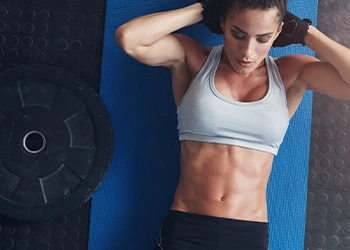
You don't exercise every other body part every day, so don't do it for your rectus abdominis either.
This is especially the case with an intense exercise routine where your muscles need some time to recover [3].
That's why I recommend working on your abs three times a week with a day to rest in between.
3. Training Variation
And finally, you should always aim to introduce training variation.
That means picking a few different exercises from the above and also switching between upper and lower abs on different training days.
Not only will this help to better shape your abs, but you won't get bored doing the same thing over and over again.
Also, if you want to reduce belly fat, you can do it with the help of natural fat burners.
Related Article: The Best Abs Exercises to Get a Six-Pack Fast
Role of Upper Abs in Overall Core Stability
The upper abdominal muscles play a pivotal role in the overall stability and strength of the core, which is essential for both athletic performance and daily activities.
The benefits of having strong upper abs include:
- Foundation for core strength: The upper abs, primarily involving the upper portion of the rectus abdominis, act as a stabilizing force for the entire core. Strengthening these muscles contributes to a more robust and stable midsection, which is crucial for balance and posture.
- Impact on posture and spinal support: Strong upper abs are vital in maintaining proper posture, along with the rest of the core [4].
- Enhanced athletic performance: In sports and physical activities, the upper abs work in conjunction with the lower abs and obliques to create a powerful core unit. This synergy is essential for efficient movement, power generation, and injury prevention in various sports, from running to weightlifting.
- Improved functional movements: Everyday activities like lifting, bending, and twisting require a strong and stable core.
FAQs
Why Do Your Upper Abs Bulge Out?
Your upper abs can bulge out due to stomach bloating and incorrect breathing techniques during weight lifting [7]. The rectus abdominis should be flat and not protrude, which would make it look out of proportion with the lower abs.
Do Planks Work Upper Abs?
Yes, planks work your upper abs, but they don't isolate them.
Planks tend to be a full-body exercise that strengthens the core, including lower and upper abs [8].
References:
- https://www.physio-pedia.com/Abdominal_Muscles
- https://physoc.onlinelibrary.wiley.com/doi/epdf/10.1113/jphysiol.2011.221200
- https://journals.lww.com/nsca-jscr/fulltext/2011/03000/recovery_after_heavy_resistance_exercise_and.26.aspx
- https://www.researchgate.net/publication/277897295_The_Effect_of_Core_Training_on_Posture
About The Author
You May Also Like



